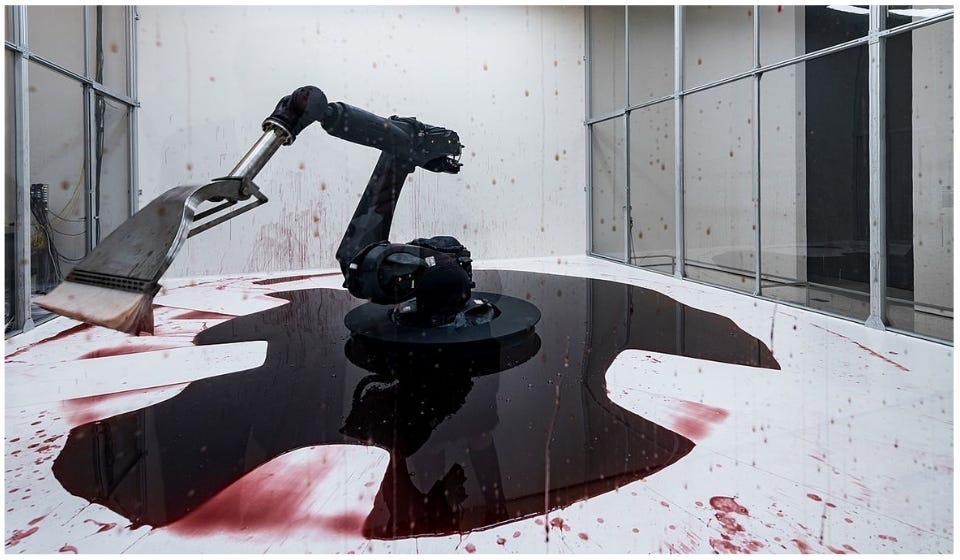Investing Is an Art, Part 1: Grab a Brush
“It is the obvious which is so difficult to see most of the time. People say 'It's as plain as the nose on your face.' But how much of the nose on your face can you see, unless someone holds a mirror up to you?” - Isaac Asimov
In 2016, the Guggenheim Museum announced a list of artists commissioned to produce works for an exclusive collection. Among the lucky selected were Chinese provocateurs Sun Yuan and Peng Yu. The duo’s resulting creation, Can’t Help Myself, would go on to be showcased in the 2019 Venice Biennale and experience near-instant virality across platforms like TikTok and Instagram.
The installation Can’t Help Myself isn’t like most art.
Centered inside a glass cage, an industrial arm lies in a pool of sanguine fluid. A hydraulic leak? You aren’t sure. Armed with sensors, the appendage scans as the strange liquid flows outwards. When it detects the fluid has spread too far, the device rakes it back in as if attempting to make itself whole again. The sensors also notice onlookers. With an audience, the machine bizarrely interrupts itself, engaging in human-like dances—whirls and spins—before reverting back to its regular, desperate routine.
You can watch a clip of the strange performance here.
As a spectator, you aren’t sure exactly what it is you’re observing. It rests somewhere between a dumb gimmick and a profound statement. Watching feels nearly voyeuristic.
Why would anyone make this? What’s the point?
Is it about energy? Wasting resource? Exploitation?
It could highlight the inevitability of death. Or the fragility of life?
Maybe it’s about depression.
Do the sensors represent government surveillance?
Perhaps there is no meaning.
The resulting uncertainty is why I love the piece so much. The installation isn’t overly complex, but it’s ambiguous—it doesn’t spoonfeed an answer. One way or another, everyone reaches their own conclusion, and as evidenced by countless arguments strewn across the internet, everyone is certain they are right.
Good art grabs attention. Great art challenges thought and forces dialogue.
In this same vein, global financial markets are great art—an installation with billions of people dually acting as participants and audience. And not unlike watching Can’t Help Myself, most people currently see a machine struggling, bleeding out, pathetically trying to avoid the inevitable.
Experimental monetary policy has left central banks stuck between a rock and a hard place. Supply chain issues. Shortages. Rampant inflation. Talks spring up of crushing demand and looming recession as people point to record public and private debt. The chaos is exacerbated by pandering politicians and manipulative media whose trompe l’oeil1 effects put M.C. Escher to shame.
A precise future is unknowable, and, yet again, everyone is certain they are right.
Granted, it’s hard not to be cynical. It’s easy to focus on the messy pool forming on the floor, and our imaginations promise no difficulty in envisioning how things could get so much worse. We’ve seen it before. But it’s worth remembering: while history is littered with all our previous woes, many we’ve caused ourselves, it also chronicles every triumph. If all you see is darkness, the often simple solution is to move. When the light hits right, you’ll discover opportunities lying where others are unwilling to look.
Have your canvas ready, and grab a brush.
Thanks for reading. If you’ve found my writings enjoyable, please consider subscribing and sharing my work.
Disclaimer
This publication’s content is for entertainment and educational purposes only. I am not a licensed investment professional. Nothing produced under the Invariant brand should be thought of as investment advice. Do your own research. All content is subject to interpretation.
Trompe l’oeil - French phrase meaning 'deceives the eye' used to describe paintings that create the illusion of a real object or scene.




